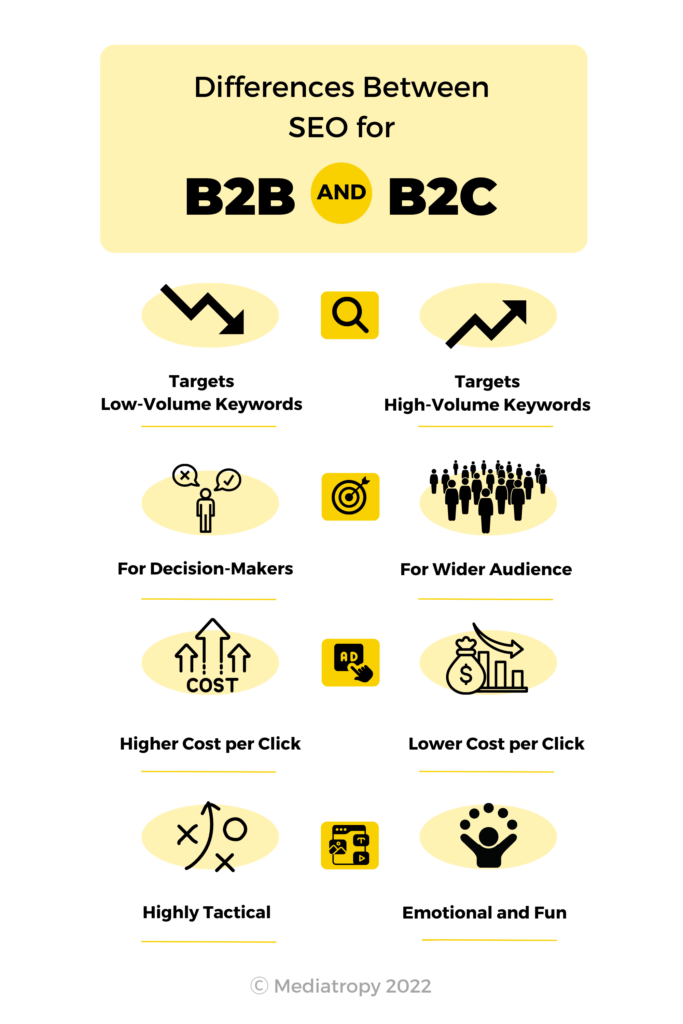Page Tidak Dapat Ditemukan
Businesses are prioritising customer experiences and how they build brand recognition. This has led to a shift in marketing strategies from offline to online. Search Engine Optimisation (SEO) is one of the most important aspects of digital marketing because it helps businesses reach their target audiences and rank higher in search engines. Search engines are the best way to target a specific audience, especially since they have become consumers’ primary source of information. Read on for our breakdown of what B2B SEO is and to explore the differences between B2C and B2B SEO. Together, we’ll also be taking a look at B2B SEO case studies to explore what works and how they can be applied to your own holistic B2B marketing strategies.
What is B2B SEO
B2B SEO is a type of search engine optimisation that is specifically designed for businesses to help them rank higher in Search Engine Results Pages (SERPs). It’s different from traditional SEO because it focuses on the needs of business-to-business companies rather than consumers. B2B SEO can be done by an agency or the company itself, but it’s important to have a strategy and know what you’re doing before you start.
The Difference Between B2C and B2B SEO
B2B SEO is more complex than B2C SEO. The main difference between the two is that B2C marketing sells products to consumers, while B2B marketing sells products to other businesses.
Check the differences between B2C SEO vs B2B SEO below:
B2C SEO provides businesses with the chance to increase their sales and reach customers who are interested in their products or services. It is also easier to create brand awareness using this SEO technique. However, B2B SEO allows companies to focus on markets that are likely more receptive to buying products from them, as it helps businesses make connections with potential partners. Search engine algorithms are different for each type of business, so the optimisation strategies have to be different too.
B2B SEO Case Studies: Success Stories
B2B SEO is a challenging game. But what’s it like to play? Let’s analyse two companies’ B2B SEO efforts, including the strategies they used to improve their rankings and how that led to improved business outcomes.
Canva
Overview
Canva is an easy-to-use design tool for non-designers. Since its inception in 2013, it has quickly grown to a $40 billion valuation. Because of its brilliant marketing strategy, it now has 60 million monthly users. In addition, this design tool performs exceptionally well in terms of SEO. It receives 73.2 million organic visitors, has over 12 million backlinks, and ranks for over 5.5 million keywords.
What they did
- Their “Create” and “Template” sections are the top landing pages that significantly contribute to their website traffic. They created these pages to rank for two different sets of keywords with different intents.
- The first set of keywords has the intent “Informational”. Users are primarily interested in learning about tools for creating a design.
- On the other hand, the intent for the second set is “Navigational”. The user wishes to navigate to a specific template page. So they’re looking for birthday card templates to create their cards eventually.
- The first set is ranked by the “Create” page, while the “Template” page ranks the second set pages are organised into logos, posters, and flyers. These categories are further subdivided into marketing, birthday card, business, and so on.
Results
- All of the category and sub-category pages are linked internally. As a result, Canva can rank for a wide range of keywords, from broad terms like “graphic templates” to more specific terms like “thanksgiving flyer template.”
- Canva receives 73.2 million organic visitors per month, ranks for the 5.5 million organic keywords, and has more than 12 million backlinks based on data from Ahrefs.

Our learnings from this case study
- Search intent is a crucial factor in SEO. Therefore, you should be aware of your intended audience before designing a page around a term.
- Organise your website such that links between each page are correct. This will help even your most specialised pages rank for particular keywords.
- Create templates to start adding new, scalable pages to your website.
HubSpot
Overview
HubSpot has millions of monthly website visitors and ranks for 37% of their keywords. This case study will help us understand how to build topical authority without being as focused on keyword stuffing.
What they did
HubSpot prioritised Topics over Keywords.
- This is how they increased their website’s topical authority:
- If you have “topical authority,” you are considered an authority on that topic. Google will rely on your responses to these search inquiries. As a result, if you submit a blog on this topic, you will be rated first.
- How did they become an expert in a given topic?
- When a website offers high-quality material on the range of search queries associated with a certain topic, it will undoubtedly obtain topical authority.
- Here’s a strategy for dealing with this:
- Select your goal topic first.
- Conduct thorough research on all potential facets of the main issue.
- For instance, content marketing is the target topic. Subtopics can be content trends, strategy, etc.
- After that, connect all of the main topic and subtopic pages together.
- This notifies the search engine that the two subjects are connected.
- Obtaining external links from websites that are already considered authorities on the subject matter might help you immensely.
- The Hub-Spoke model is used by Hubspot to carry this out. The main topic page, in this case, is the Hub, which is linked to the Spokes, or the subtopics, through the Spokes. The Hub-Spoke model consists of three components that work together to form a topic hub.

-
- The Home Page (Hub)
- This is the page that links to the rest of the pages.
- Typically, this page covers broad topics and does not target long-tail keywords.
- The Sub-pages
- This consists of pages that cover all of the topics covered on the main page. Here, we focus on long-tail keywords with high volume and low difficulty.
- Here, we focus on long-tail keywords with high volume and low difficulty.
- Internal Linking
- Internal linking has now connected all of the main and sub-pages.
- This assists search engines in determining that these pages are related.
- Search engines eventually determine that the said domain has authority on the topic covered by the main page after spotting the connection.
Results
- HubSpot excels particularly in its blogs. According to Ahrefs, the blog.hubspot.com link receives 10 million monthly visitors on their website which equates to 74% of HubSpot’s monthly traffic.
- The other links such as “blog.hubspot.com/marketing”, and “blog.hubspot.com/sales” also perform exceptionally well.
- These blog pages are divided primarily into these two categories. However, the terms “marketing” and “sales” are extremely broad. As a result, HubSpot goes above and beyond to create more topic hubs under the umbrella topic of “marketing” and “sales.” HubSpot refers to these hubs as “topic clusters.”
Our learnings from this case study
- Google prefers topics to keywords and will certainly reward you for continuously writing on topics related to your domain.
- You should concentrate on creating content for your users rather than optimising for Google. Great content will always triumph over any SEO trick as search engine algorithms become smarter!
The Importance of Having a Comprehensive B2B SEO Marketing Strategy
B2B SEO Marketing is one of the most important aspects for any company looking to grow its business. For those in the B2B space, it is even more important. To succeed with SEO marketing, you need to have a comprehensive strategy in place.
When creating a B2B SEO marketing strategy, you need to understand your target audience, what they’re looking for, and how they search. You also need to understand your own business and where it fits in the marketplace. Finally, you need to know what content will help your target audience decide about their company’s needs.
This includes setting up and managing your website, optimising your website content, establishing an email marketing campaign, and optimising your on-site SEO efforts. Of course, there are many other things that can be done as well, such as blogging, guest posting, social media management and more.
The Ultimate Guide to B2B SEO Strategy in 5 Steps
Here is a 5-step B2B SEO strategy to guide you in formulating an effective strategy for your B2B company to outperform the competitive market:
- Develop your buyer persona and define your sales funnel.
- Perform keyword research based on your personas.
- Build a keyword strategy to target buyers at different phases of your funnel.
- Create a scalable content strategy and design optimised landing pages.
- Promote your content to obtain backlinks.
Sources:
https://buildd.co/marketing/canva-seo-case-study
https://buildd.co/marketing/hubspot-seo-strategy
https://www.semrush.com/blog/b2b-seo/
If you are looking for help with implementing these strategies or want to learn more about how they work together with your existing digital marketing efforts, reach out to us!
